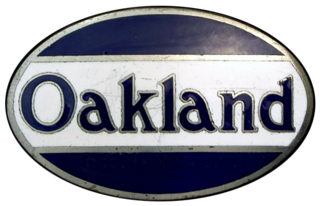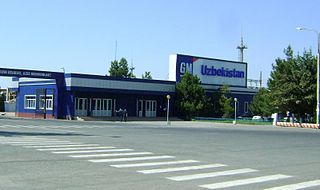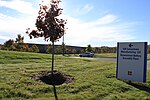
Chevrolet, colloquially referred to as Chevy and formally the Chevrolet Motor Division of General Motors Company, is an American automobile division of the American manufacturer General Motors (GM). Louis Chevrolet (1878–1941) and ousted General Motors founder William C. Durant (1861–1947) started the company on November 3, 1911 as the Chevrolet Motor Car Company. Durant used the Chevrolet Motor Car Company to acquire a controlling stake in General Motors with a reverse merger occurring on May 2, 1918, and propelled himself back to the GM presidency. After Durant's second ousting in 1919, Alfred Sloan, with his maxim "a car for every purse and purpose", would pick the Chevrolet brand to become the volume leader in the General Motors family, selling mainstream vehicles to compete with Henry Ford's Model T in 1919 and overtaking Ford as the best-selling car in the United States by 1929 with the Chevrolet International.
New United Motor Manufacturing, Inc. (NUMMI) was an American automobile manufacturing company in Fremont, California, jointly owned by General Motors and Toyota that opened in 1984 and closed in 2010.

The Oakland Motor Car Company of Pontiac, Michigan, was an American automobile manufacturer and division of General Motors. Purchased by General Motors in 1909, the company continued to produce modestly priced automobiles until 1931 when the brand was dropped in favor of the division's Pontiac make.
Arlington Assembly is a General Motors automobile factory located in Arlington, Texas. The plant has operated for more than 60 years and today manufactures large SUVs from GM's divisions Chevrolet, GMC and Cadillac.
Flint Assembly is an automobile factory operated by General Motors in Flint, Michigan. It is the city's only main plant after the closure of Buick City. As of 2022, the Flint factory currently produces full-size pickup trucks. Engine block and cylinder heads were cast at Saginaw Metal Casting Operations, internal engine components were created at Bay City Powertrain and the engines were then assembled at Tonawanda Engine and Romulus Engine. For most of the 20th century Flint Assembly was the home factory for all Chevrolet vehicles.

Janesville Assembly Plant is a former automobile factory owned by General Motors located in Janesville, Wisconsin. Opened in 1919, it was the oldest operating GM plant when it was largely idled in December 2008, and ceased all remaining production on April 23, 2009. The demolition of the plant began in April 2018.

Wilmington Assembly was a General Motors automobile factory in Wilmington, Delaware. The 3,200,000-square-foot (300,000 m2) factory opened in 1947, and produced cars for GM's Chevrolet, Pontiac, Saturn, Opel, Buick and Daewoo brands during its operation. GM closed the plant on July 28, 2009.
Linden Assembly was a General Motors automobile factory in Linden, New Jersey. The plant operated from 1937 to 2005 and made cars, trucks and SUVs for various GM automotive divisions. Engine block and cylinder heads were cast at Saginaw Metal Casting Operations, internal engine components were created at Bay City Powertrain and the engines were then assembled at assembled at Tonawanda Engine and Romulus Engine.

St. Louis Truck Assembly was a General Motors automobile factory that built GMC and Chevrolet trucks, GM "B" body passenger cars, and the 1954–1981 Corvette models in St. Louis. Opened in the 1920s as a Fisher body plant and Chevrolet chassis plant, it expanded facilities to manufacture trucks on a separate line. During World War II, the plant produced the DUKW amphibious vehicles for the military. Another expansion was added for the Corvette line in 1953.

Fremont Assembly was a General Motors automobile factory in Fremont, California in the San Francisco area, replacing the older Oakland Assembly. Groundbreaking for the plant occurred in September 1961, and the plant produced its first vehicle on May 1, 1963. Production continued through March 1, 1982, when the plant was closed after production problems. After closure, the plant was refurbished and reopened as the more successful NUMMI joint-venture between GM and Toyota between 1984 and 2010, and later became the Tesla Factory in 2010.

The North Tarrytown Assembly was an automobile factory in North Tarrytown, New York now known as Sleepy Hollow, situated on the Hudson River. The 90-acre (36 ha) plant was in operation from 1896 to 1996. Originally opened by the Stanley Steam Car Company, the plant was acquired by Maxwell-Briscoe in 1903 from the Ingersoll-Rand Drill Company. In 1913 Maxwell-Briscoe was renamed Maxwell Automobile Company. Separate portions of the complex were acquired by Chevrolet in 1914 and 1915. At this time Chevrolet was an independent company and not yet part of General Motors. In 1918 Chevrolet was integrated into General Motors.
Oshawa Truck Assembly was a General Motors Canada automotive factory in Oshawa, Ontario, Canada. It opened in its original location in downtown Oshawa in 1918 in order to build ambulances for World War I and Chevrolet vehicles before it merged with GM.

Oshawa Assembly is a manufacturing facility in the city of Oshawa, Ontario, Canada, that built various automobiles for General Motors Canada. Vehicles were primarily produced for the US, Canadian, and Mexican markets, but they also built exports for various countries around the world, particularly South America and the Middle East. Historically the Oshawa plant was the source of all right-hand-drive market GM exports with complete vehicles or knock-down kits shipped to Australia, New Zealand, South Africa, and the United Kingdom until the end of the 1960s. At one time, the factory was one of the largest auto manufacturing facilities in the world, with two car assembly plants, a truck assembly plant, as well as parts production including Harrison radiators, AC Delco batteries and American Axle. Between 1999 and 2019, it had won more quality and productivity awards than any other GM plant. The plant is part of the larger GM Autoplex.
Pontiac Assembly was one of four General Motors assembly plants in Pontiac, Michigan located along Baldwin Avenue. It served as the home factory for GM's Pontiac Motor Division since it was built in 1927. It was across the street from the currently operational Pontiac Metal Center, which was the original location for the Oakland Motor Car Company, which Pontiac evolved out of. It was also sometimes identified as being located in the city of Bloomfield, Michigan.
South Gate Assembly was a General Motors automobile plant located at 2720 Tweedy Boulevard in the Los Angeles suburb of South Gate, California. It opened in 1936 to build B-O-P (Buick-Oldsmobile-Pontiac) cars for sale on the west coast. It was the first GM plant to build multiple car lines, resulting from a Depression-spawned move to cut production costs by sharing components and manufacturing. South Gate was the second of several B-O-P "branch" assembly plants, part of GM's strategy to have production facilities in major metropolitan cities. Engine block and cylinder heads were cast at Saginaw Metal Casting Operations, internal engine components were created at Bay City Powertrain and the engines were then assembled at Tonawanda Engine and Romulus Engine.

UzAuto Motors is an automotive manufacturer owned by the Government of Uzbekistan. It is based in Asaka, Uzbekistan. It manufactures vehicles under the marques Chevrolet and Ravon, which is Uzbek for calm and straight road or easy journey.
Avtotor is an automobile manufacturing company located in Kaliningrad Oblast, Russia. Avtotor was established in 1996. By 2008, it was one of the largest producers and assemblers of cars in the world. Industry publication Automotive Manufacturing Solutions estimates the company's revenue for 2011 at 4 billion euros and total employees at 3,500, although credit rating agency Expert estimated total revenue in 2017 at $689 million.

Before 1992, Uzbekistan had no automotive industry, being part of the Soviet Union. In post-Soviet times, UzDaewooAuto, SamKochAvto, GM Uzbekistan new auto producing plants were built with South Korean and American help. With production surpassing more than 200,000 per year, Uzbekistan exports automobiles to Russia and other CIS countries.
Buffalo Assembly was a former General Motors manufacturing facility located in Buffalo, New York that produced Chevrolet vehicles. In 1923, GM opened the factory to build the Chevrolet Superior and while Chevrolet also had a factory at North Tarrytown Assembly the address was 1001 East Delevan Avenue and continued to manufacture until WWII, when it was refitted to build rear axles for passenger cars and trucks. In 1984, Chevrolet-Buffalo became part of GM-Saginaw where it was renamed Saginaw Gear and Axle. Production and operations ended in 2007. The Chevrolet Buffalo factory represented a long history of building automobiles in the area, along with Pierce-Arrow and the earlier Thomas Motor Company, while Ford still maintains a factory to date. It is currently identified as the Historic American Axle Building.
Saginaw Metal Casting Operations is an automobile engine foundry plant in Saginaw, Michigan. Opened under GM management in 1919, the factory produces engine blocks and cylinder heads for General Motors vehicles. The factory currently occupies 1.9 million square feet on 490 acres. The location was originally the Marquette Motor Company until acquired by William Durant in 1909 when the car was discontinued in 1911. During World War I, it was used to manufacture mortar shells for the US Ordnance Corps, then was repurposed for engine block casting when operations at Northway Motor and Manufacturing Division ended in 1925. Historically in September 1927 it was known as the Chevrolet Grey Iron Foundry. In the past when it was called GM-Saginaw Product Company (SPC) a cloverleaf casting symbol mark was cast onto the iron component.











